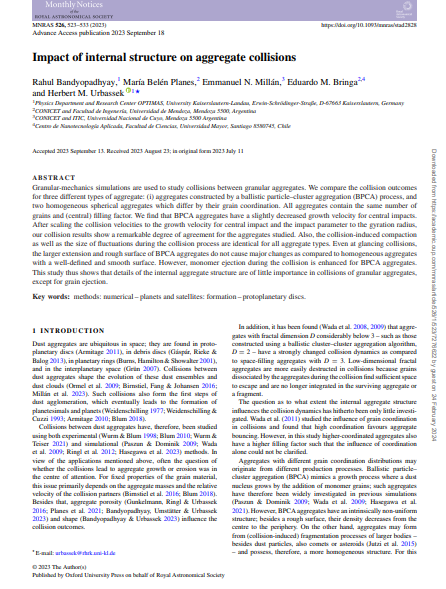Impact of internal structure on aggregate collisions

Fecha
2023-09-18Autor
Bandyopadhyay, Rahul
Planes, María Belén
Millán, Emmanuel N.
Bringa, Eduardo M. [Centro de Nanotecnología Aplicada, Facultad de Ciencias, Universidad Mayor, Chile]
Urbassek, Herbert M.
Ubicación geográfica
Notas
HERRAMIENTAS
Acceda a títulos restringidos
¿Cómo descargar?Resumen
Granular-mechanics simulations are used to study collisions between granular aggregates. We compare the collision outcomes for three different types of aggregate: (i) aggregates constructed by a ballistic particle–cluster aggregation (BPCA) process, and two homogeneous spherical aggregates which differ by their grain coordination. All aggregates contain the same number of grains and (central) filling factor. We find that BPCA aggregates have a slightly decreased growth velocity for central impacts. After scaling the collision velocities to the growth velocity for central impact and the impact parameter to the gyration radius, our collision results show a remarkable degree of agreement for the aggregates studied. Also, the collision-induced compaction as well as the size of fluctuations during the collision process are identical for all aggregate types. Even at glancing collisions, the larger extension and rough surface of BPCA aggregates do not cause major changes as compared to homogeneous aggregates with a well-defined and smooth surface. However, monomer ejection during the collision is enhanced for BPCA aggregates. This study thus shows that details of the internal aggregate structure are of little importance in collisions of granular aggregates, except for grain ejection.
URI
https://repositorio.umayor.cl/xmlui/handle/sibum/9456https://academic.oup.com/mnras/article-pdf/526/1/523/51740937/stad2828.pdf
https://doi.org/10.1093/mnras/stad2828
https://cnap.umayor.cl/publicaciones/impact-of-internal-structure-on-aggregate-collisions
https://ui.adsabs.harvard.edu/link_gateway/2023MNRAS.526..523B/PUB_PDF
Coleccion/es a la/s que pertenece:
Si usted es autor(a) de este documento y NO desea que su publicación tenga acceso público en este repositorio, por favor complete el formulario aquí.